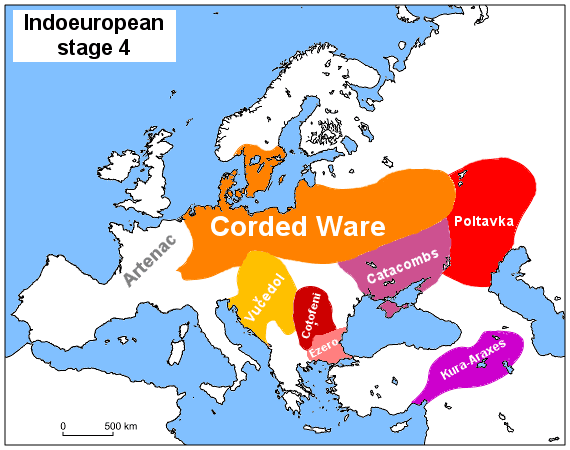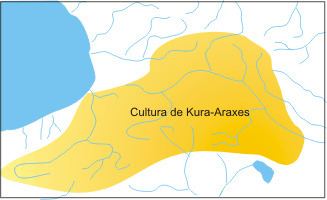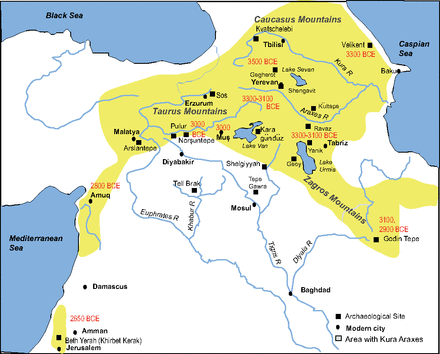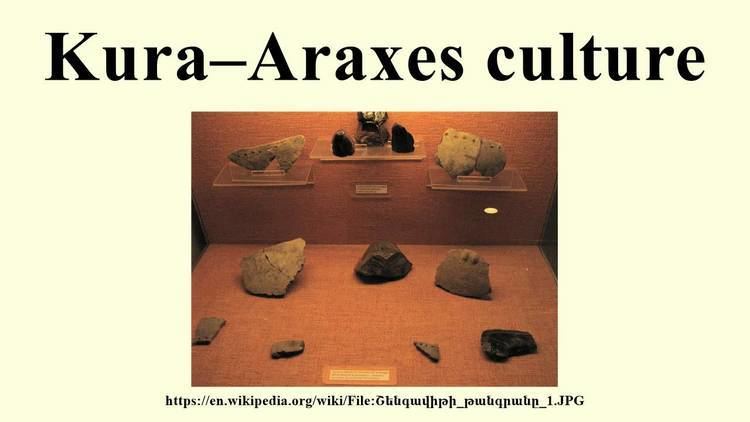Major sites Shengavit | Followed by Trialeti culture | |
Dates circa 3,400 B.C.E. — circa 2,000 B.C.E. Preceded by Shulaveri-Shomu culture | ||
Kura araxes culture
The Kura–Araxes culture or the early trans-Caucasian culture was a civilization that existed from 3400 BC until about 2000 BC, which has traditionally been regarded as the date of its end; in some locations it may have disappeared as early as 2600 or 2700 BC. The earliest evidence for this culture is found on the Ararat plain; it spread northward in Caucasus by 3000 BC (but never reaching Colchis).
Contents
- Kura araxes culture
- Early history
- Expansion
- Settlements
- Kura Araxes mounds
- Economy
- Metallurgy
- Goods
- Viticulture
- Culture
- Ethno linguistic makeup
- References

Altogether, the early trans-Caucasian culture enveloped a vast area approximately 1,000 km by 500 km, and mostly encompassed, on modern-day territories, the Southern Caucasus (except western Georgia), northwestern Iran, the northeastern Caucasus, eastern Turkey, and as far as Syria.

The name of the culture is derived from the Kura and Araxes river valleys. Kura–Araxes culture is sometimes known as Shengavitian, Karaz (Erzurum), Pulur, and Yanik Tepe (Iranian Azerbaijan, near Lake Urmia) cultures. It gave rise to the later Khirbet Kerak-ware culture found in Syria and Canaan after the fall of the Akkadian Empire.

Early history

Shulaveri-Shomu culture preceded the Kura–Araxes culture in the area. There were many differences between these two cultures, so the connection was not clear. Later, it was suggested that the Sioni culture of eastern Georgia possibly represented a transition from the Shulaveri to the Kura-Arax cultural complex.

At many sites, the Sioni culture layers can be seen as intermediary between Shulaver-Shomu-Tepe layers and the Kura-Araxes layers. This kind of stratigraphy warrants a chronological place of the Sioni culture at around 4000 BCE.
Nowadays scholars consider the Kartli area, as well as the Kakheti area (in the river Sioni region) as key to forming the earliest phase of the Kura–Araxes culture. To a large extent, this appears as an indigenous culture of Caucasus that was formed over a long period, and at the same time incorporating foreign influences.
There are some indications (such as at Arslantepe) of the overlapping in time of the Kura-Araxes and Uruk cultures; such contacts may go back even to the Middle Uruk period.
Expansion
Rather quickly, elements of Kura–Araxes culture started to proceed westward to the Erzurum plain, southwest to Cilicia, and to the southeast into the area of Lake Van, and below the Urmia basin in Iran, such as to Godin Tepe.
Finally, it proceeded into the present-day Syria (Amuq valley), and as far as Palestine.
Its territory corresponds to large parts of modern Armenia, Azerbaijan, Chechnya, Dagestan, Georgia, Ingushetia, North Ossetia, and parts of Iran and Turkey.
At Sos Hoyuk, in Erzurum Province, Turkey, early forms of Kura-Araxes pottery were found in association with local ceramics as early as 3500-3300 BC. During the Early Bronze Age in 3000-2200 BC, this settlement was part of the Kura-Araxes phenomenon.
At Arslantepe, Turkey, around 3000 BCE, there was widespread burning and destruction, after which Kura-Araxes pottery appeared in the area.
Settlements
Archaeological evidence of inhabitants of the Kura–Araxes culture showed that ancient settlements were found along the Hrazdan river, as shown by drawings at a mountainous area in a cave nearby. Structures in settlements have not revealed much differentiation, nor was there much difference in size or character between settlements, facts that suggest they probably had a poorly developed social hierarchy for a significant stretch of their history. Some, but not all, settlements were surrounded by stone walls. They built mud-brick houses, originally round, but later developing into subrectangular designs with structures of just one or two rooms, multiple rooms centered around an open space, or rectilinear designs.
At some point the culture's settlements and burial grounds expanded out of lowland river valleys and into highland areas. Although some scholars have suggested that this expansion demonstrates a switch from agriculture to pastoralism and that it serves as possible proof of a large-scale arrival of Indo-Europeans, facts such as that settlement in the lowlands remained more or less continuous suggest merely that the people of this culture were diversifying their economy to encompass crop and livestock agriculture.
Shengavit Settlement is a prominent Kura-Araxes site in present-day Yerevan area in Armenia. It was inhabited from approximately 3200 BC cal to 2500 BC cal. Later on, in the Middle Bronze Age, it was used irregularly until 2200 BC cal. The town occupied an area of six hectares, which is large for Kura-Araxes sites.
Kura-Araxes mounds
In the 3rd millennium B.C., one particular group of mounds of the Kura–Araxes culture is remarkable for their wealth. This was the final stage of culture's development. These burial mounds are known as the Martqopi (or Martkopi) period mounds. Those on the left bank of the river Alazani are often 20-25 meter high and 200-300 meter in diameter. They contain especially rich artefacts, such as gold and silver jewelry.
Economy
The economy was based on farming and livestock-raising (especially of cattle and sheep). They grew grain and orchard crops, and are known to have used implements to make flour. They raised cattle, sheep, goats, dogs, and in later phases, horses.
Before the Kura-Araxes period, horse bones were not found in Transcaucasia. Later, beginning about 3300 BCE, they became widespread, with signs of domestication.
There is evidence of trade with Mesopotamia as well as Asia Minor. It is, however, considered above all to be indigenous to the Caucasus, and its major variants characterized (according to Caucasus historian Amjad Jaimoukha) later major cultures in the region.
Metallurgy
In the earliest phase of the Kura–Araxes culture, metal was scarce. In comparison, the preceding Leilatepe culture's metalwork tradition was far more sophisticated.
The Kura–Araxes culture would later display "a precocious metallurgical development, which strongly influenced surrounding regions". They worked copper, arsenic, silver, gold, tin, and bronze.
Their metal goods were widely distributed, from the Volga, Dnieper and Don-Donets river systems in the north to Syria and Palestine in the south and Anatolia in the west.
Goods
Their pottery was distinctive. The spread of their pottery along trade routes into surrounding cultures was much more impressive than any of their achievements domestically. It was painted black and red, using geometric designs. Examples have been found as far south as Syria and Israel, and as far north as Dagestan and Chechnya. The spread of this pottery, along with archaeological evidence of invasions, suggests that the Kura-Araxes people may have spread outward from their original homes and, most certainly, had extensive trade contacts. Jaimoukha believes that its southern expanse is attributable primarily to Mitanni and the Hurrians.
They are also remarkable for the production of wheeled vehicles (wagons and carts), which were sometimes included in burial kurgans.
Viticulture
Viticulture and wine-making were widely practised in the area from the earliest times. Viticulture even goes back to the earlier Shulaveri-Shomu culture.
The earliest evidence of domesticated grapes in the world has been found at Gadachrili Gora, near the village of Imiri, Marneuli Municipality, in southeastern Republic of Georgia; carbon-dating points to the date of about 6000 BC.
Grape pips dating back to the V-IVth millennia B.C. were found in Shulaveri; others dating back to the IVth millennium B.C. were found in Khizanaant Gora—all in this same 'Shulaveri area' of the Republic of Georgia.
A theory has been suggested by Stephen Batiuk that the Kura-Araxes folk may have spread Vitis vinifera vine and wine technology to the “Fertile Crescent”—to Mesopotamia and the Eastern Mediterranean. The spread of wine-goblet form, such as represented by the Khirbet Kerak ware, is clearly associated with these peoples. The same applies to the large ceramic vessels used for grape fermentation.
Culture
The culture is closely linked to the approximately contemporaneous Maykop culture of Ciscaucasia. As Amjad Jaimoukha puts it,
"The Kura-Araxes culture was contiguous, and had mutual influences, with the Maikop culture in the Northwest Caucasus. According to E.I. Krupnov (1969:77), there were elements of the Maikop culture in the early memorials of Chechnya and Ingushetia in the Meken and Bamut kurgans and in Lugovoe in Serzhen-Yurt. Similarities between some features and objects of the Maikop and Kura-Araxes cultures, such as large square graves, the bold-relief curvilinear ornamentation of pottery, ochre-coloured ceramics, earthen hearth props with horn projections, flint arrowheads, stone axes and copper pitchforks are indicative of a cultural unity that pervaded the Caucasus in the Neolithic Age."
Inhumation practices are mixed. Flat graves are found but so are substantial kurgan burials, the latter of which may be surrounded by cromlechs. This points to a heterogeneous ethno-linguistic population (see section below). Late in the history of this culture, its people built kurgans of greatly varying sizes, containing widely varying amounts and types of metalwork, with larger, wealthier kurgans surrounded by smaller kurgans containing less wealth. This trend suggests the eventual emergence of a marked social hierarchy. Their practice of storing relatively great wealth in burial kurgans was probably a cultural influence from the more ancient civilizations of the Fertile Crescent to the south.
According to Giulio Palumbi (2008), the typical red-black ware of Kura–Araxes culture originated in eastern Anatolia, and then moved on to the Caucasus area. But then these cultural influences came back to Anatolia mixed in with other cultural elements from the Caucasus.
Ethno-linguistic makeup
Hurrian and Urartian language elements are quite probable, as are Northeast Caucasian ones. Some authors subsume Hurrians and Urartians under Northeast Caucasian as well as part of the Alarodian theory. The presence of Kartvelian languages was also highly probable. Influences of Semitic languages and Indo-European languages are highly possible, though the presence of the languages on the lands of the Kura–Araxes culture is more controversial.
In the Armenian hypothesis of Indo-European origins, this culture (and perhaps that of the Maykop culture) is identified with the speakers of the Anatolian languages.
The expansion of Y-DNA subclade R-Z93 (R1a1a1b2), according to Mascarenhas et al. (2015), is compatible with "the archeological records of eastward expansion of West Asian populations in the 4th millennium BCE, culminating in the socalled Kura-Araxes migrations in the post-Uruk IV period." According to Pamjav et al. (2012), "Inner and Central Asia is an overlap zone" for the R -Z280 and R -Z93 lineages, implying that an "early differentiation zone" of R-M198 "conceivably occurred somewhere within the Eurasian Steppes or the Middle East and Caucasus region as they lie between South Asia and Eastern Europe". According to Underhill et al. (2014/2015), R1a1a1, the most frequent subclade of R1a, split into R-Z282 (Europe) and R-Z93 (Asia) at circa 5,800 before present, in the vicinity of Iran and Eastern Turkey. According to Underhill et al. (2014/2015), "[t]his suggests the possibility that R1a lineages accompanied demic expansions initiated during the Copper, Bronze, and Iron ages."
